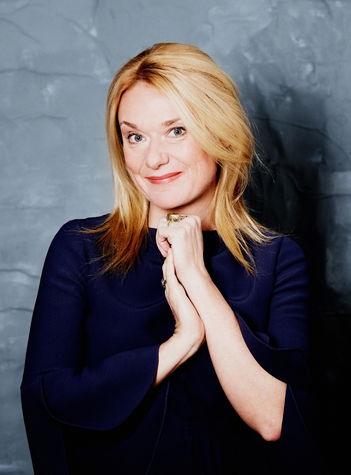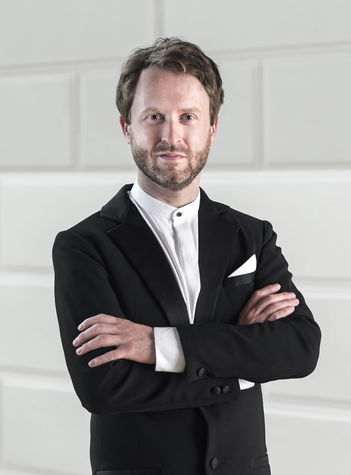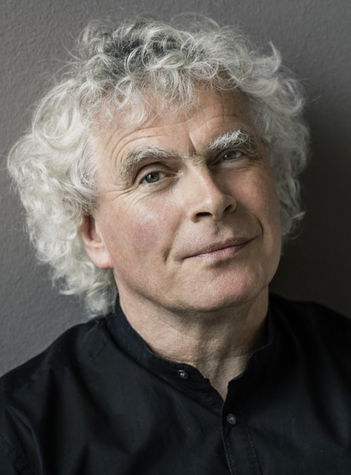Programme
Claude Debussy
Nocturnes, L 98
Olivier Messiaen
Poèmes pour Mi, book two
Gustav Mahler
Symphony No. 4 in G major
Secure your seat for the 2025/2026 season – presales are open.
Choose SubscriptionIn this colourful programme, we encounter the pairing of the conductor Simon Rattle and mezzo-soprano Magdalena Kožená. In Debussy’s Nocturnes we find traces of his inspiration from nocturnal paintings of rivers. Messiaen’s Poèmes pour Mi plays with surrealistic, spiritual, and romantic colours. Gustav Mahler does not hold anything back, either—his Fourth Symphony includes a vocal part.
Subscription series A
Claude Debussy
Nocturnes, L 98
Olivier Messiaen
Poèmes pour Mi, book two
Gustav Mahler
Symphony No. 4 in G major
Magdalena Kožená soprano
Prague Philharmonic Choir women’s choir
Lukáš Vasilek choirmaster
Simon Rattle conductor
Czech Philharmonic

Spring enchained, light rainbow of morning,
Ah! my necklace! Ah! my necklace!
Small living support of my weary ears,
Necklace of renewal, of smiles, of grace,
Oriental necklace, chosen, multicoloured
With hard, whimsical pearls!
Curving landscape, espousing the fresh morning air,
Ah! my necklace! Ah! my necklace!
Your two arms round my neck, this morning.
– Olivier Messiaen: Poèmes pour Mi
It is characteristic that the necklace around Messiaen’s neck in his surrealistic poem is multicoloured. When the French composer first saw the stained glass windows of the Sainte-Chapelle chapel in Paris at the age of ten, he experienced a fascination that influenced him all his life. Besides being keenly interested in ornithology, he was well known for having chromesthesia—aural stimulation created associations in his mind with colours. “I don’t see the colours with my eyes, but I do see them in my mind. It is necessary to see how sound moves. The notes come one after another like the colours of a rainbow. It’s a fleeting thing that cannot ever be captured fully.”
He regarded birds as the best artists, and he enjoyed recording birdsong. For human musicians, he added at least some instructions on how to conceive a particular composition in terms of colour. “I don’t expect them to see the same shades of colour as I do—that is not even possible—but for them each to perceive the colours in their own way.”
Messiaen dedicated his Poèmes pour Mi to his first wife, Claire Delbos, whom he nicknamed “Mi”. The cycle, with texts inspired by the New Testament, describes the relationship and shared spiritual path of a husband and wife, and it points to another theme that runs through the composer’s works—the Christian faith.
Another colourful work was written by one of Messiaen’s favourite composers, Claude Debussy, whose music is often described as the musical equivalent of Impressionists’ brushstrokes, in which the subjectivity of what is perceived comes to the fore. Debussy was inspired to write his three-movement composition Nocturnes by a series of paintings with the same title by James Whistler that use light to capture the atmosphere of the Thames and other rivers. Just like Messiaen’s Poèmes pour Mi, the work had its premiere in the year of the composer’s 29th birthday.
Gustav Mahler was just two years older at the premiere of his Fourth Symphony. In his symphony, the traditionally generous composer included a song about a child’s vision of heaven, which he had already considered using in his Third Symphony. About working with the Czech Philharmonic, mezzo-soprano Magdalena Kožená says: “I was completely enchanted by the orchestra’s sound in Maher. In fact, my husband also says the orchestra has the most beautiful and most authentic sound that Mahler would have liked most of all.”
Magdalena Kožená soprano

Like on many past occasions, Magdalena Kožená is returning to her homeland with her husband, Sir Simon Rattle. Kožená, a graduate of the Brno Conservatoire and of the Academy of Performing Arts in Bratislava, came to worldwide attention thanks in part to victory at the International Mozart Competition in 1995; four years later she signed an exclusive contract with the label Deutsche Grammophon, for which she has released many award-winning recordings (Gramophone Award, Echo Klassik, Diapason d’Or etc.). She divides her performing activities between recitals, concert appearances, and operatic roles including regular guest appearances at New York’s Metropolitan Opera. She also performs in such non-classical genres as swing and flamenco. Her classical repertoire is of remarkable breadth, ranging from the baroque era and collaborations with ensembles specialising in early music to the classical and romantic repertoire, in which she has won fame in part as a proponent of Czech music, and onwards to the music of today.
Prague Philharmonic Choir
The Prague Philharmonic Choir (PPC), founded in 1935 by the choirmaster Jan Kühn, is the oldest professional mixed choir in the Czech Republic. Their current choirmaster and artistic director is Lukáš Vasilek, and the second choirmaster is Lukáš Kozubík.
The choir has earned the highest acclaim in the oratorio and cantata repertoire, performing with the world’s most famous orchestras. In this country, they collaborate regularly with the Czech Philharmonic and the Prague Philharmonia. They also perform opera as the choir-in-residence of the opera festival in Bregenz, Austria.
Programmes focusing mainly on difficult, lesser-known works of the choral repertoire. For voice students, they are organising the Academy of Choral Singing, and for young children there is a cycle of educational concerts.
The choir has been honoured with the 2018 Classic Prague Award and the 2022 Antonín Dvořák Prize.
Lukáš Vasilek choirmaster

Lukáš Vasilek studied conducting and musicology. Since 2007, he has been the chief choirmaster of the Prague Philharmonic Choir (PPC). Most of his artistic work with the choir consists of rehearsing and performing the a cappella repertoire and preparing the choir to perform in large-scale cantatas, oratorios, and operatic projects, during which he collaborates with world-famous conductors and orchestras (such as the Berlin Philharmonic, the Czech Philharmonic, the Israel Philharmonic, and the Saint Petersburg Philharmonic).
Besides leading the PPC, he also engages in other artistic activities, especially in collaboration with the vocal ensemble Martinů Voices, which he founded in 2010. As a conductor or choirmaster, his name appears on a large number of recordings that the PPC have made for important international labels (Decca Classics, Supraphon); in recent years, he has been devoting himself systematically to the recording of Bohuslav Martinů’s choral music. His recordings have received extraordinary acclaim abroad and have earned honours including awards from the prestigious journals Gramophone, BBC Music Magazine, and Diapason.
Simon Rattle conductor

We have seen one of today’s most distinguished conductors, Sir Simon Rattle, relatively often at the Rudolfinum in recent years. His long-term cooperation with the Czech Philharmonic has led to his appointment together with his wife, mezzo-soprano Magdalena Kožená, as Artist-in-Residence for the 2022/2023 season. At his appearances with the Czech Philharmonic, he has performed a number of symphonic works and, most notably, compositions for voices and orchestra from the late 19th and early 20th centuries, the repertoire for which Rattle has been the most acclaimed. He appeared most recently at the Rudolfinum in February 2024 with the pianist Yuja Wang, with whom he made a Grammy-nominated recording from their joint tour of Asia in 2017. From the 2024/2025 season, he becomes the Principal Guest Conductor of the Czech Philharmonic.
A native of Liverpool and a graduate of the Royal Academy of Music has held a series of important positions in the course of his long career. He came to worldwide attention as the chief conductor of the Birmingham Symphony Orchestra, where he was employed for a full 18 years (for eight years as its music director); next came 16 years with the Berlin Philharmonic (2002–2018; artistic director and chief conductor) and six years with the London Symphony Orchestra. He opened the 2023/2024 season as chief conductor of the Bavarian Radio Symphony Orchestra. He also leads the Orchestra of the Age of Enlightenment with the title of “principle artist”, and he is the founder of the Birmingham Contemporary Music Group. Besides holding full-time conducting posts, he maintains ties with the world’s leading orchestras and gives concerts frequently in Europe, the USA, and Asia.
He has made more than 70 recordings for EMI (now Warner Classics). He has won a number of prestigious international awards for his recordings including three Grammy Awards for Mahler’s Symphony No. 10, Brahms’s German Requiem, and Stravinsky’s Symphony of Psalms, which he recorded with the Berlin Philharmonic.
Besides the prizes mentioned above, Rattle’s long-term partnership with the Berlin Philharmonic also led to the new educational programme Zukunft@Bphil, which has achieved great success. Even after moving on from that orchestra, Rattle did not abandon his engagement with music education, and he has taken part together with the London Symphony Orchestra in the creation of the LSO East London Academy. Since 2019, that organisation has been seeking out talented young musicians, developing their potential free of charge regardless of their origins and financial situation.
Claude Debussy
Nocturnes, L 98
Olivier Messiaen
Poèmes pour Mi
Gustav Mahler
Symfonie č. 4 G dur
At the turn of the nineteenth and twentieth centuries, from the summer of 1899 until April 1901, Mahler composed his Symphony No. 4, the most classical of his monumental symphonies. The composition has roots that reach back even further in time, however. During the frigid February of 1892, Mahler composed the song Der Himmel hängt voll Geigen for voice and piano to a text from the poetry collection The Youth’s Magic Horn, which contains more than seven hundred texts of old German folksongs and popular songs. The collection had been published nearly a century earlier in 1806–1808 by the young poets Achim von Arnim and Clemens Brentano. Mahler discovered it by chance in 1887 while visiting the grandson of the composer Carl Maria von Weber, and he drew on it for subject matter for his compositions for another fourteen years. A month after composing the song, in March 1892 Mahler finished orchestrating it with the characteristic use of harp and sleigh bells, and he gave it his own title, Das himmlishe Leben (Heavenly Life). He took a special liking for the song, and he often included it on concert programmes of his music. It was originally to have been the conclusion of this Third Symphony, but ultimately that colossal work would have “just” six movements, and Heavenly Life instead became the finale, intellectual focus, and climax of the Fourth Symphony.
It might seem that the Fourth Symphony is just a continuation and completion of the Third, but already in the first movement we hear unmistakeable fanfares that foreshadow Mahler’s Fifth Symphony, which was yet to come. In Mahler’s music, everything is closely tied together.The second movement, although dancelike, makes an oppressive impression – it is, after all, also a dance of death played on the fiddle by the skeleton Freund Hein! The solo violin is to be tuned a step higher to give it a harsher, shriller tone, making the soloist sound like a street musician instead of a concertmaster of a symphony orchestra. Mahler is said to have taken inspiration from Arnold Böcklin’s 1872 painting titled Self-Portrait with Death Playing the Fiddle. (In 1894, the same painting also inspired Jaroslav Vrchlický’s poem, in which a painter is creating a self-portrait but constantly feels something disturbing behind his back. When he turns around, he sees Death with a fiddle.)The third movement is the longest. It is a magnificent series of variations inspired by the vision of a tombstone on which there is a carved image of the departed in eternal sleep. The music leads us to a vision of heaven’s gates.
Beyond the gates we are welcomed by a “child’s” voice – a soprano – in heaven, where peace reigns supreme, where there is no bustle of the secular world, where everyone can rejoice and dance. And with this image of childlike naivety, Mahler completes his journey from the complex to the simple, from experience to innocence, and from earthly life to heavenly bliss.
In the twenty-first century, Mahler’s music and its message are still attractive to listeners. The form, content, and intellectual and emotional power of the music make it surprisingly relevant to our post-modern epoch.
In this colourful programme, we encounter the pairing of the conductor Simon Rattle and mezzo-soprano Magdalena Kožená. In Debussy’s Nocturnes we find traces of his inspiration from nocturnal paintings of rivers. Messiaen’s Poèmes pour Mi plays with surrealistic, spiritual, and romantic colours. Gustav Mahler does not hold anything back, either—his Fourth Symphony includes a vocal part.